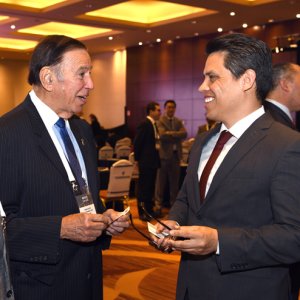
Communication Between Mining Companies and Communities
Many complex calculations lay behind the success of a mining project. Chief among them is the relationship with the local community. A good relationship can mean smooth sailing, while a troubled one might lead to delays and even mine closures. During the fourth edition of Mexico Mining Forum, panelists agreed on the importance of this relationship and analyzed best practices to ensure a successful approach and impact on the local community.
“Involving society in the mining process is now a real demand that requires the participation of the entire industry,” said Moderator David Guillén, Founding Partner of Rios Ferrer, on Wednesday at Sheraton Maria Isabel in Mexico City. Guillén highlighted the importance of the sector to Mexico’s economy, especially considering that it represents 4 percent of the country’s GDP.
The economic impact of the mining industry goes far beyond its mayor players. He adds that 70 percent of Mexico’s mining sector are micro companies with less than 10 employees and highlights that these economic benefits can also trickle down to the community living next to a mining project. However, change is often seen with distrust so companies must ensure that communities feel involved in the changes that are happening to their surroundings.
The relationship between operators and the community is key to the mining company, explained Luiz Camargo, Director of Finances and Corporate Affairs of Minera Cuzcatlán. He quoted a study by EY that identified “permission to operate” among the Top 10 major risks for a mining company, which refers not just to government approval but permission from the local community where the mine is located. José Antonio Berlanga, CEO of Telson Mining Corporation, agreed on the relevance of involving communities from the start of the project. “It is necessary to begin projects by communicating with local communities or they can halt these projects,” he said.
Renato Urresta, Principal Consultant at ERM, did not skirt he image issues that might pose concerns to local communities. “The mining sector is a development engine but it is still controversial. One of the reasons is its strong link to poverty, as communities close to mining projects have a 76 percent poverty rate.” However, he highlighted the role mining projects can have in improving said communities. “It is necessary for companies to work closely with local governments to empower these mining communities.”
Through research of the social impact of the mine it is possible to create strategies to act in the area and develop agreements with local communities to develop win-win situations for both parties, agreed Camargo.
As mines can last for up to 50 years, staying for long terms allows companies to develop complex community projects to empower the local population, explained Urresta. He called on the audience to analyze their own engagement plans with local communities and measure their impact. The speaker highlighted the importance of developing social engagement teams from the beginning of the project that support community from the beginning. “If we don’t develop social engagement plans, the mining sector will face an increased resistance in local communities.”
The impact of a good relationship might extend far beyond he company and the community. “Companies generate platforms alongside the local authorities that lead to the pacification of the state,” said Camargo referring to Mexico’s insecurity concerns and how they affect mining companies. Mario Salomón, Country Manager of Multisistemas de Seguridad Industrial, agreed on the three-part link between mining operations, community and safety. “The most important aspect of security is prevention, for that reason we strongly promote personal responsibility among our employees,” said Salomón.
All speakers agreed that a mine’s success often relies on fully understanding the area it is located in. Camargo used a project in Oaxaca as an example. As the region has a significant number of indigenous communities, the company performed a comprehensive sociological study to fully understand local customs and develop strategies to promote social development. The other speakers agreed, with Berlanga going on to summarize the panel. “The most important thing is to ensure close communication with the community at all times.”
















